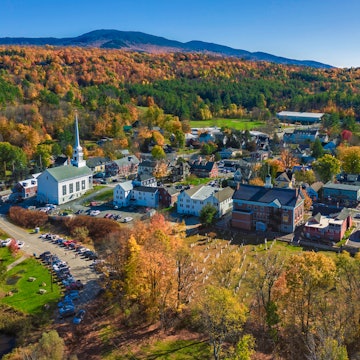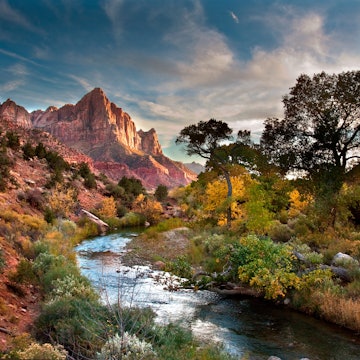
Copy My Trip: Glamping and hiking at Utah’s Bryce Canyon and Capitol Reef National Parks
Sponsored by

Aug 15, 2023 • 6 min read

Stopping for a snap at a scenic overlook atop Bryce Canyon, one of Utah’s Mighty Five national parks © Deepa Lakshmin / Lonely Planet
When I think of Utah, I think of national parks. In addition to well-known Zion, Arches, Canyonlands, Capitol Reef and Bryce Canyon make up the “Mighty Five” – a must for many hikers’ bucket lists.
As part of Lonely Planet’s social team, I’d seen those red rocks time and time again on my newsfeed. And when the opportunity came up to visit Capitol Reef and Bryce Canyon, I had the privilege of finally experiencing them for myself.
Disclaimer: I’ve never been to Zion, Arches or Canyonlands, so I can’t compare and contrast them all. I’m more of a casual hiker, the kind of person who’s a city girl at heart but likes to get outside, challenge herself a bit and look at pretty landscapes as a reminder of how big and bright the world is.
Southwestern Utah delivered exactly what I was looking for – and then some.
Where did you stay? What was the vibe?
For two nights, I and a handful of other travel journalists stayed at Under Canvas Bryce Canyon, just 15 minutes away from the park.
It puts the “glam” in glamping.
My private tent somehow fit a full bed and bathroom – a real toilet and hot shower, score! – along with a seating area. It felt like a normal hotel room, except that I had to unzip it to get inside and light a stove to stay warm overnight. Since the property and other guests were pretty spread out (the main lobby tent was a 10-minute walk away), I felt alone but not too alone. I got my fill of socializing at the fire pits, where travelers swapped stories and snacked on s’mores after dinner. There’s zero wi-fi and limited cell signal here, which means you can truly disconnect and stay in the moment.
Closer to Capitol Reef in Torrey, we checked into Skyview, which recently opened in one of Utah’s many International Dark Sky–designated communities. My double room included an outdoor hot tub with a front-row seat to the red rocks (and the cattle grazing beside them). Unfortunately for me, the hotel’s domes – deluxe bubble tents with skylights for stargazing – weren’t open to the public yet; ideally, I would’ve slept in one of those to round out my glamping experience. Still, the desert is so secluded that even in the brick-and-mortar rooms you’ll feel like you’re off the grid. There were limited dining options in a town this small: I loved grabbing a cider at the nearby Etta Place or breakfast at Wild Rabbit Cafe, and feeling that the local Torrey community appreciated my business.

What’s the most under-the-radar activity you enjoyed?
The thing about popular hikes is that you’re inevitably going to get stuck in a bottleneck waiting to scramble over a rock or shuffle through a narrow path. For a New Yorker as impatient as I am, that really kills the mood. Enter Sulfur Creek trail at Capitol Reef, a 5.8-mile trek of untouched nature that was gloriously devoid of other people. Mason, a guide at Sleeping Rainbow Adventures, led my group through the slot canyons while teaching us about the geological wonders around us. It was good to have someone to follow, since there’s literally nothing made by humans here: no trail markers, no signs, no bathrooms, no trash cans. There are also no steep inclines, which made my legs very happy.
The most fun part was descending via the creek’s waterfalls; if you go, be sure to wear waterproof everything. While the water level varies throughout the year (check the National Park Service so you know what conditions to expect), it can get as high as your chest, so put your stuff in dry bags and leave anything cotton in your room. I started the hike in normal socks and sneakers, then switched to neoprene socks with sport sandals once we hit the creek. You’re wading through water over slippery rocks, so you’ll need shoes that support your ankles.

Best thing you ate?
The drive from Torrey to Bryce Canyon is just as much of an attraction as the parks it connects. We cruised Scenic Byway 12 and stopped in Boulder, Utah for a true farm-to-table lunch at Hell’s Backbone Grill & Farm (so named due to a rugged stretch with sharp drops on either side of the road). Chefs Blake Spalding and Jen Castle founded the restaurant over two decades ago with a focus on sustainable agriculture rooted in the land’s rich history. One of the most delicious dishes we tried was made with Fremont beans native to southwestern Utah. I’d never seen beans this big before, and it was cool to know I was eating something Indigenous communities had been harvesting in the area for centuries. Even the food I eat all the time, like strawberries, somehow taste better when you watch someone pick them out of the ground.
Runner-up for my favorite meal was pizza delivery from Garden Patch in Torrey. Owner Beth rolled up to Skyview with her wood-fired oven attached to her car and made us roadside pies, right then and there. I’m lactose intolerant and do my best to avoid cheese; her pesto-and-veggies made for the best – yes, best – cheeseless slice I’ve ever had.

What was the most touristy thing you did?
At Bryce Canyon, I hopped on an e-bike and (after a few laps around a parking lot to double-check I hadn’t forgotten how to ride) coasted along the Canyon 2 Canyon trail. I was happy we took e-bikes instead of old-school bicycles, since I could glide through the ponderosa pines and appreciate the wind on my face rather than stressing about pedaling fast enough to keep up with more-experienced bikers.
After we made a quick pit stop in Old Bryce Town (a nice break if you want to feel like you’re in a cheesy western movie) and took the obligatory tourist photo in front of the Bryce Canyon National Park sign, we arrived at Inspiration Point. This is a stunning overlook from which to ooh and aah over the hoodoos – so do expect large tour groups, and be sure to bring your camera.

What is the one thing that you did not expect?
The nights were surprisingly chilly for a Utah summer. Because Torrey is at over 6000ft of elevation and Bryce Canyon even higher, you should expect much cooler temperatures in these towns versus those in Moab or Salt Lake City, which can hit 90° to 100°F. I found the mid-June weather to be warm and sunny during the day: perfect for hiking.
In the evenings, I needed a light puffer. At Under Canvas, I had to get extra blankets from the front desk because once the fire in my stove went out, it was uncomfortably cold no matter how much fleece I layered on. So if you’re headed on a similar trip to Capitol Reef or Bryce Canyon, pack both waterproof clothes to splash around in waterfalls and a warm jacket to bundle up when the sun goes down. You’ll thank me later.
Deepa traveled to Utah at the invitation of Visit Utah. Lonely Planet does not accept freebies in exchange for positive coverage.
Sponsored by Utah Office of Tourism
As a travel entertainment and inspirational media outlet, we sometimes incorporate brand sponsors into our efforts. This activity is clearly labeled across our platforms.
This story was crafted collaboratively between Utah Office of Tourism and Lonely Planet. Both parties provided research and curated content to produce this story. We disclose when information isn’t ours.
With sponsored content, both Lonely Planet and our brand partners have specific responsibilities:
-
Brand partner
Determines the concept, provides briefing, research material, and may provide feedback.
-
Lonely Planet
We provide expertise, firsthand insights, and verify with third-party sources when needed.















